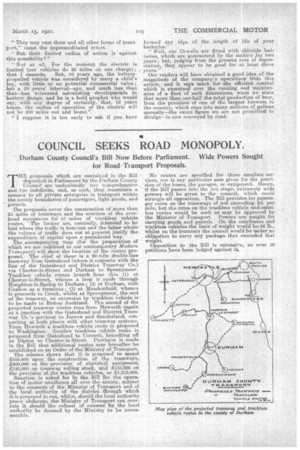COUNCIL SEEKS ROAD MONOPOLY.
Page 15

If you've noticed an error in this article please click here to report it so we can fix it.
Durham County Council's Bill Now Before Parliament. Wide Powers Sought for Road Transport Proposals.
THE proposals which are contained in the Bill. deposited in Parliament by the Durham County Council are undoubtedly too comprehensive and too indefinite, and, as such, they constitute a menace to all private enterprise in transport -within the county boundaries of passengers, light, goods, and parcels.
'Me proposals cover the construction of more than 23 miles of tramways and the erection of the overhead equipment for 57 miles of trackless vehicle routes. The former are, naturally, intended to be laid where the traffic is heaviest and the latter where the volume of traffic does net at present justify the expenditure of capital upon a permanent way. The accompanying map (for the preparation of which we are indebted to our contemporary Modern Transport) will show the location of the routes proposed. The chief of these is a 20.mile double-line tramway from Gateshead (where it connects with the line of the Gateshead and District Tramway Co.) via Chesterde-Street and Durham to Spennymoor. Trackless vehicle routes branch from this (1) at Chester-le-Street, whence a loop is made through Houghton-le-Spring to Durham.; (2) at Durham, with Coxhoe as a terminus; (3) at blea.dowfield, whence it proceeds to Crook, whilst at Spennymoor, the end of the tramway, an extension by trackless vehicle is to be made to Bishop Auckland. The second of the projected tramway routes runs from Heworth (again M a junction with the Gateshead and District Tramway Co.'s services) to Jarrow and Sunderland, eon.necting at both places with other tramway systems. From Heworth a trackless vehicle route is proposed to Washington. Another trickles vehicle route is proposed from Gateshead to Consett, branching off at Dipton to Chester-le-Street. Provision is made in the Bill that additional routes may hereafter be established on an Order of the Ministry of Transport.
The scheme shows that it is proposed to spend 150,000 upon the construction of the tramways, £400,000 on the provision of electrical equipment, £120,000 on tramway rolling stock, and 2143,000 on tho provision of-the trackless vehicles, or 1,513,000. Sanction is asked for in the Bill for the operation of motor omnibuses all over the county, subject to the consents of the Minister of Transport and of the local authority of the district through which it is proposed to run, whilst, should the local authority prove obdurate, the Ministry of Transport can overrule it should the refusal of consent by the local authority be deemed by the Ministry to be unreaeonable.
No routes are specified for these omnibus services, nor is any particular sum given for the provision of the buses, the garages, or equipment. Hence, if the Bill passes into the Act stage, extremely wide powers will be given to the council, which could strangle all opposition. The Bill provides for passenger rates on the tramways of not exceeding 2d. per mile, but the rates on the trackless vehicle and,omnibus routes would be such as may be approved by the Minister of Transport. Powers are sought for carrying goods and parcels. On the omnibuses and trackless vehicles the limit of weight would bet56 lb., Whilst on the tramcars the council would be under no obligation to carry any package that exceeded that weight.
Opposition to the Bill is extensive, as over 30 petitions have been lodged against it.
































